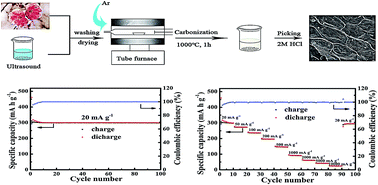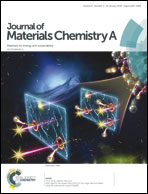Expanded biomass-derived hard carbon with ultra-stable performance in sodium-ion batteries†
Abstract
A hard carbon sheet-like structure has been successfully prepared with a short flow process by simply using cherry petals (CPs) as the raw materials. The sodium storage mechanism in CPs was detected with cyclic voltammetry (CV) and X-ray photoelectron spectroscopy (XPS). Encouragingly, when being assessed as an anode electrode for sodium-ion batteries (SIBs), the CP electrode can provide a high initial reversible capacity of 310.2 mA h g−1 with a favorable initial Coulomb efficiency of 67.3%, delivering a high retention rate of 99.3% at 20 mA g−1 after 100 cycles. Even at a high current density of 500 mA g−1, the reversible capacity can reach 146.5 mA h g−1, indicating that the high rate performance is excellent as well. Such a preferable performance may be derived from the prepared structures with sufficient mesopores, the presence of nitrogen/oxygen functional groups on the surface and the expanded interlayer distances (∼0.44 nm), which enable reversible sodium-ion storage through surface adsorption and sodium intercalation.



 Please wait while we load your content...
Please wait while we load your content...